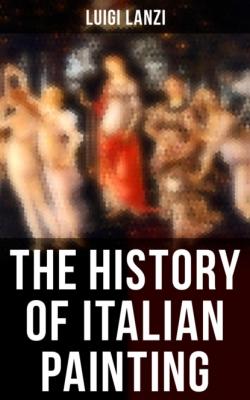The History of Italian Painting. Luigi Lanzi
Чтение книги онлайн.
Читать онлайн книгу The History of Italian Painting - Luigi Lanzi страница 1

Luigi Lanzi
The History of Italian Painting
Published by
Books
- Advanced Digital Solutions & High-Quality eBook Formatting -
musaicumbooks@okpublishing.info
2021 OK Publishing
EAN 4064066382186
Table of Contents
VOLUME 1
Table of Contents
HISTORY OF PAINTING IN LOWER ITALY.
EPOCH II.
EPOCH III.
EPOCH IV.
EPOCH V.
EPOCH II.
EPOCH III.
PREFACE.
When detached or individual histories become so numerous that they can neither be easily collected nor perused, the public interest requires a writer capable of arranging and embodying them in the form of a general historical narrative; not, indeed, by a minute detail of their whole contents, but by selecting from each that which appears most interesting and instructive. Hence it mostly happens, that the diffuse compositions of earlier ages are found to give place to compendiums, and to succinct history. If this desire has prevailed in former times, it has been, and now is, more especially the characteristic of our own. We live in an age highly favourable, in one sense at least, to the cultivation of intellect: the boundaries of science are now extended beyond what our forefathers could have hoped, much less foreseen; and we become anxious only to discover the readiest methods of obtaining a competent knowledge, at least, of several sciences, since it is impossible to acquire them all. On the other hand, the ages preceding ours, since the revival of learning, being more occupied about words than things, and admiring certain objects that now seem trivial to the generality of readers, have produced historical compositions, the separate nature of which demands combination, no less than their prolixity requires abridgment.
If these observations are applicable to other branches of history, they are especially so to the history of painting. Its materials are found ready prepared, scattered through numerous memoirs of artists of every school which, from time to time, have been given to the public: and additional articles are supplied by dictionaries of art, letters on painting, guides to several cities, catalogues of various collections, and by many tracts relating to different artists, which have been published in Italy. But these accounts, independent of want of connexion, are not useful to the generality of readers. Who, indeed, could form a just idea of painting in Italy by perusing the works of certain historians of latter ages, and some even of our own time, which abound in invectives, and in attempts to exalt favourite masters above the artists of all other schools; and which confer eulogies indiscriminately upon professors of first, second, or third-rate merit?[2] How few are there who feel interested in knowing all that is said of artists with so much verbosity by Vasari, Pascoli, or Baldinucci; their low jests, their amours, their private affairs, and their eccentricities? What do we learn by being informed of the jealousies of the Florentine artists, the quarrels of the Roman, or the boasts of the Bolognian schools? Who can endure the verbal accuracy with which their wills and testaments are recorded, even to the subscription of the notary, as if the author had been drawing up a legal document; or the descriptions of their stature and physiognomy, more minute than the ancients afford us of Alexander or Augustus?[3] Not that I object to the introduction of such particulars in the lives of the great luminaries of art: in a Raffaello or a Caracci minute circumstances derive interest from the subject; but how intolerable do they become in the life of an ordinary individual, where the principal incidents are but little interesting? Suetonius has not written the lives of his Cæsars and his grammarians in the same manner: the former he has rendered familiar to the reader; the latter are merely noticed and passed over.
The tastes of individuals, however, are different, and some people delight in minutiæ, as it regards both the present and the past; and since it may be of utility to those who may hereafter be inclined to give a very full and perfect history of every thing relating to Italian painting, let us view with indulgence those who have employed







